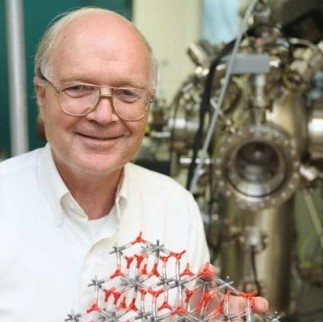Richard Osgood
Columbia University, United StatesFor the invention of laser photochemical deposition and the application of laser induced photochemical reactions to materials processing.

Science surrounded Rick when he was growing up - his father was an engineer and his grandfather was interested in instruments and minerals and metals. Rick followed their interests, enjoying all types of science related books. This fascination continued through high school where he had two inspiring chemistry teachers.
After high school, Rick did not take a traditional academic path. He enrolled at West Point, the U.S. Military Academy, where he studied science and engineering, including organic chemistry and quantum mechanics. Upon graduation, he went into the U.S. Air Force and took advantage of a program that allowed new officers to work in research laboratories, and did research lasers at the U.S. Air Force Avionics Laboratory at Wright-Patterson Air Force Base in Ohio. Rick says that he “got hooked” there on lasers and optics, which led to discoveries in molecular-based infrared lasers. During this time, he took the opportunity to broaden his science outlook and met some of the major scientists in optics, gas dynamics, and lasers effects in the US.
After leaving the Air Force, Rick went to MIT on a Hertz Fellowship to study physics with renowned physicist Ali Javan. Although they were two very different people with different backgrounds, they worked well together. It was in Javan’s lab that Rick learned about gas molecule vibrational spectroscopy and expanded his knowledge and discovered many new forms of high-power lasers. Rick was inspired by Javan, who was “an extraordinarily creative scientist”. Javan was one of Rick’s mentors and his passing in 2016 was a “major loss for optical physics.”
Rick has had a long and successful career – of 52 years, but it was not without obstacles. When he started in the Air Force lab, he knew nothing about lasers, and there weren’t many people around to give him advice. He “just did what he thought he was logical to do and taught himself”. Working with William Eppers, he developed the first high power CO laser in 1968-1969. He regards this as one of his greatest accomplishments. Since then, he’s many years of research in lasers and surface science including the photochemical surface modification, at MIT Lincoln Laboratories, and silicon photonics and surface chemistry at Columbia. Later in 2000, he became Associate Lab Director for Basic Energy Science at Brookhaven National Laboratory (BNL) in Long Island, New York. During this time interval, he worked to plan for the new Synchrotron source, guided work in free electron lasers, and led the effort to secure a major nanocenter at BNL. He says that basic science and its early applications are his primary interest, with his major interest being in lasers and surface physics and chemistry.
Today, Rick is Emeritus Higgins Professor of Applied Physics and of Electrical Engineering at Columbia University in New York. While he is technically retired, he is still supervising some students as they complete their degrees. They, and many of the PhD students – 68!- through the years, have been deeply involved with OSA activities. Rick says that OSA offers great opportunities for student to learn of other fields of optics and to interact with peers and senior scientists. He has attended OSA conferences such as CLEO and FiO for virtually his entire professional life and many of the people he’s known most of his professional life, such as Past OSA President Erich Ippen, Peter Moulton, Alan Willner, and Steve Brueck, have all been involved with OSA.
When it comes to giving his students advice, Rick says that “to do research, you have to do a lot of things well.” He goes on to explain that you have to know how to develop new science insights, write proposals, communicate with collaborators, funders, and the public, and do many things at once. He notes that research is “about more than just calculations or research in the lab.” Ultimately, it is important to have persistence and drive and a thirst for new discoveries and understanding to be successful.
Profile written by Jeanette Gass
